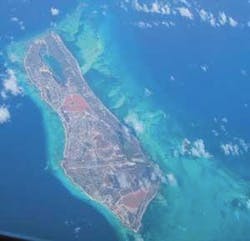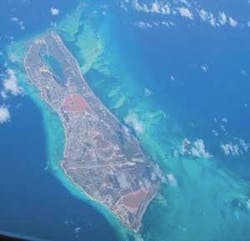Desalinated water supplements rainwater system
By: Fernando Pérez Monteagudo
Sustainability must be the goal of water resources management in small islands, and Grand Turk, the capital of Turks and Caicos Islands, is carefully preserving its complex water supply system fed mainly by rainwater and supplemented by desalination.
Grand Turk is a very small island with an area of about 18 km2. Rainwater is the main source of water supply and is widely developed at the household and community level. Almost all buildings and houses use their own rainfall collection system composed by roof catchments, gutters and cisterns. A roof frequently covers these cisterns for catchment purposes.
Rainfall supplies the island's water supply system, which includes 27 tanks with a storage capacity of 19,000 m3 fed by three large ground catchments, two minor ones and the others fed by roof catchments.
Since there is no guarantee that rain will fall in the volume that would fill all public and residential storage systems, the Turks and Caicos Islands government purchased three reverse osmosis (RO) plants to meet possible rain shortfalls. These units produce 681.81 m3/day of water in total.
The government developed an island-wide distribution network that has considerably enhanced the possibilities of satisfying the increasing demand of the population installing domestic and commercial connections. The water supply system originally consisted of storage tanks, catchment areas, RO plants and a main pipe linking and transferring water between all tanks, which only supplied tanker loading points, stand points for the population and some public buildings.
Scarce freshwater resources in small islands, such as Grand Turk, emphasise the importance of water demand management. Consequently, non-potable water resources have been developed on the island to alleviate the demand on potable sources, conserving them for other uses.
Saltwater is used not only for producing desalinated drinking water. Some zones are partially supplied with salt water for flushing purposes. The risk of corrosion is minimal because plastic pipes and fittings are used for the system and in buildings. The houses and buildings so supplied reduce the need for freshwater, which comes mainly from their own roof catchment systems. This led decision-makers to construct a parallel distribution system of salt water - a move that reduced demand for fresh water by laying additional pipes in the same trenches as freshwater pipes. In other areas, wells will be bored in each community to supply salt water through small-pressurised systems for toilet flushing toilets. Salt water for flushing is provided free of charge in some poor communities to reduce health risks from poorly constructed pit latrines.
No reliable estimates of water production costs are available, but some rough estimates establish cost at US$ 7.92 per m3. Current tariffs are US$ 2.64/m3 at public standpoints and US$ 7.92/m3 for government offices, cistern trucks and domestic or commercial network users. Cistern truck vendors charge US$ 13.2/m3.
Pollution can occur in many rainwater systems although water quality is generally good. In Grand Turk, RO-produced water of excellent quality is blended with lower quality rainwater supplied by the system and also in its final destination, with the building's rainwater collection system.
Disinfection is necessary to ensure adequate microbiological quality. The distribution system coexists with vending kiosks and cistern trucks, so chlorine residual needed to maintain standards might be higher than appropriate and difficult to control.
Drinking water quality is an urgent problem that must be carefully studied. Quality standards are met at the point of building connection, but the dwelling storage system may lower the quality below desired levels.
Current analysis of rainwater harvesting and water management in Grand Turk demonstrates notable achievements, but highlights challenges for the government and all agencies involved.
Proposals for consideration
- Comparison study of imported bottled water vs. local production of bottled water using existing RO plants;
- Installation of domestic purifying systems;
- Implementation of a comprehensive water quality monitoring network that includes all system components.
Author's note
Dr. Fernando Pérez Monteagudo is a full professor in the Centre for Hydraulic Research in Havana, Cuba. He can be contacted at [email protected]

